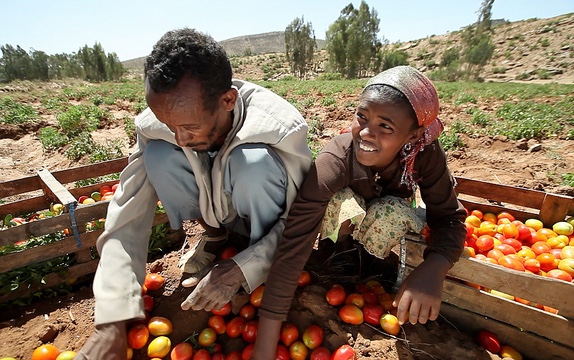A diverse and nutrient-dense diet is key in the fight against malnutrition. However, in many developing countries, poor households are unable to afford an adequately nutritious diet. A recent study by Fantu Bachewe, Kalle Hirvonen, Bart Minten, and Feiruz Yimer of IFPRI’s Ethiopia Strategy Support Program (ESSP) looks at the rising prices of non-staple foods over the past ten years in Ethiopia, where children eat the least diverse diets in all of Africa south of the Sahara and many suffer from stunted growth as a result.
Improving nutrition is thus high on the policy agenda of the government of Ethiopia. The government’s Growth and Transformation Plan II aims to reduce the stunting rate in children from 40 percent in 2014-2015 to 26 percent by 2020.
In rural Ethiopia, many people depend on their own food production; if there is not adequate access to markets to round out their diets, those diets will consist mainly of staple foods like cereals and pulses. The ESSP study found that households that grow the majority of their food but that also have easy access to markets have more diverse diets than those without access to markets. However, even with market access, poorer households may not be able to afford nutritionally rich foods.
The researchers analyzed consumer price patterns of various food groups over the last decade using a large-scale price dataset collected monthly by the Central Statistical Agency (CSA) of Ethiopia in 116 urban retail markets across the country. The results show that the price of vitamin A-rich leafy green vegetables has risen by 80 percent between 2007 and 2016. During the same period, the price of other fruits and vegetables has risen by 40 percent, and the price of legumes and nuts rose by around 30 percent. The price of animal food sources, such as dairy, eggs, and meat, also rose by about 30 percent. However, the prices of staple crops like grains, roots, and tubers stayed the same during the study period, and the price of oils, fats, and sugar decreased.
The rising price of nutritious foods like fruits and vegetables, legumes and nuts, and animal proteins is concerning, the authors say, because consumption of these foods, which are rich in macro- and micronutrients, is already low in Ethiopia. Although obesity is less of a problem in Ethiopia than in other countries, there has also been a rise in both overweight adults and high blood pressure and diabetes over the past decade. The authors argue that this is in direct correlation to the decrease in sugar and oil prices.
The authors also point out that their findings were qualitatively similar for retail prices in rural areas. The rural price of animal products rose more than the price in urban markets, while the price of other fruits and vegetables remained generally the same. Overall, however, increases in the real prices of fruits, vegetables, nuts, and legumes in areas where most households are engaged in cereal production shows that the production and productivity of these more nutritious crops has lagged behind demand.
These findings have important policy implications. The Ethiopian government has a good track record in improving cereal production in the country over the past decade. Through modernizing the agricultural sector with technological advances, farmers have been able to increase their agricultural productivity and production, which has helped to alleviate poverty and increase caloric intake. However, there is still a financial barrier for low-income households to afford fruits, vegetables, and animal products, which are needed to combat stunting in children and malnutrition in both children and adults.
Jenn Campus is a freelance writer. This post first appeared on the IFPRI Africa South of the Sahara Food Security Portal blog.







